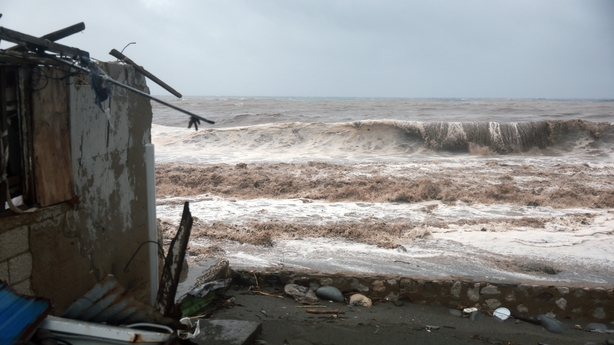Hurricane Beryl has smashed into the Mexican coast near top beach destinations, whipping palm trees with strong winds as a steady rain falls, after forging a deadly trail of destruction across much of the Caribbean.
The hurricane's core shifted over the Yucatan Peninsula, with maximum sustained winds dipping slightly to around 161kph as it reached the coastal resort town of Tulum.
While the storm's center moving through Tulum resulted in slower winds and some downed tree branches, the US National Hurricane Center forecast dangerous storm surges and destructive waves in the surrounding area.
The state governor urged residents to remain indoors.
"We're asking everyone to stay in your homes, in your shelters, do not leave," said Quintana Roo Governor Mara Lezama in a video message on social media platform X.
We need your consent to load this comcast-player contentWe use comcast-player to manage extra content that can set cookies on your device and collect data about your activity. Please review their details and accept them to load the content.Manage Preferences
Among Mexico's top tourist destinations, the Yucatan is known for its white-sand beaches, lush landscapes and Mayan ruins.
Beryl, currently at Category 2 strength, is the first hurricane of the 2024 Atlantic season. It became this week the earliest Category 5 hurricane on record, with scientists pointing to its rapid strengthening as almost certainly fueled by human-caused climate change.
Mexico's civil protection agency has issued a red alert, signaling a maximum hazard threat.
Videos posted on social media today showed fierce winds battering Tulum's downtown.
Quintana Roo schools were closed and Mexico's defence ministry opened around 120 storm shelters ahead of Beryl's arrival.

Before reaching Mexico, Beryl wreaked havoc across several Caribbean islands. It swept through Jamaica, Grenada, St Vincent and the Grenadines, in addition to unleashing heavy rainfall on northern Venezuela.
It has claimed at least 11 lives, tearing apart buildings while felling power lines and trees.
The death toll may rise as more information becomes available.

Beryl is expected to weaken rapidly as it crosses the Yucatan Peninsula, but then regain strength after it re-emerges in the Gulf of Mexico. The NHC predicts that the storm will move toward northeastern Mexico and south Texas late in the weekend.
Hurricane Beryl forced the evacuation of around 3,000 tourists from Isla Mujeres, a popular tourist island near Mexico's top beach resort of Cancun, according to the island's tourism director Jose Magana.
Many residents had sought refuge in shelters in anticipation of the storm's impact.
About 100 flights were canceled at Cancun's main airport yesterday, causing tourists to rush to catch the last outgoing flights.

Mexico's major oil platforms, primarily located in the southern rim of the Gulf of Mexico, are not expected to be affected or shut down, but oil projects in US waters to the north may be affected if the hurricane continues on its expected path.
Research by the Clima Meter consortium determined that climate change significantly intensified Hurricane Beryl. According to the study, the storm's severity, along with its associated rainfall and wind speed, saw an increase of 10-30% as a direct result of climate change.

Fisherman Jose Martin was one of several who docked his boat in Cancun ahead of Beryl's arrival.
"It affects us a good deal because, first, we can't work, and second, we need to find shelter, so it's not good," Mr Martin said.

